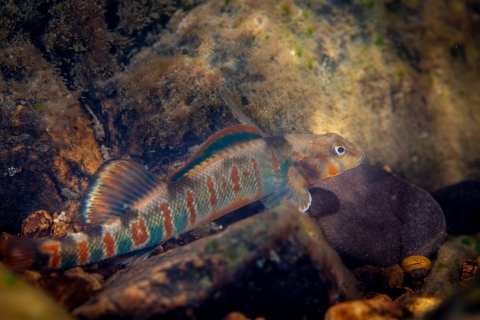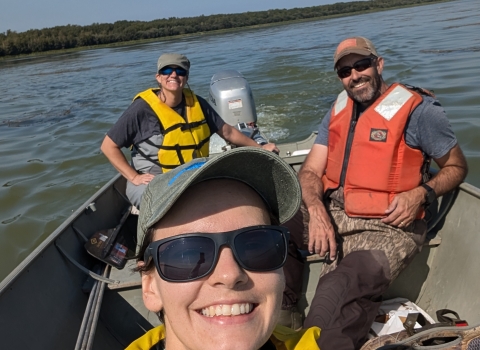2023 marks the 50th anniversary of the enactment of the Endangered Species Act (ESA), one of the most important wildlife conservation laws in the United States. Since 1973, the ESA has protected threatened and endangered species and their Critical Habitat nationally.
A major threat to imperiled species is loss of habitat. For centuries, humans have been changing landscapes through development. Expanding cities, farmland, and roads have taken away habitat from wildlife, which can put some species at-risk of extinction. And in our waterways, dams are harming wildlife too. Dams and other barriers block access to essential habitat for fish and other animals that rely on free-flowing rivers. When these critters no longer have access to their traditional feeding and spawning areas, they can start to decline towards extinction. The National Fish Passage Program directly supports the recovery of species listed under the Endangered Species Act by removing these barriers and restoring access for aquatic wildlife to their historic habitat. Since 1999, the National Fish Passage Program has removed over 3,400 barriers and reopened access to over 61,000 stream miles.
In 2021, the Bipartisan Infrastructure Law (BIL) provided an additional $200 million investment for fish passage fish passage
Fish passage is the ability of fish or other aquatic species to move freely throughout their life to find food, reproduce, and complete their natural migration cycles. Millions of barriers to fish passage across the country are fragmenting habitat and leading to species declines. The U.S. Fish and Wildlife Service's National Fish Passage Program is working to reconnect watersheds to benefit both wildlife and people.
Learn more about fish passage projects over the next five years, expanding fish passage restoration capacity unlike ever before. In just the first two years, the U.S. Fish and Wildlife Service and partners have started 35 BIL-funded fish passage projects that support the recovery of over 40 endangered and threatened species across the country. Below are five examples of ESA-listed species that benefit from BIL-funded fish passage projects.
1. Candy Darter
While this small fish may look like it belongs in the tropics, the candy darter is only found in Virginia and West Virginia’s upper Kanawha River Basin. The candy darter is listed as threatened by the ESA because over half of the known populations have disappeared since 1932. Threats include habitat destruction, the introduction of other species, and habitat fragmentation caused by barriers. The 2023 Upper Greenbrier River Watershed Fish Passage project removes seven barriers within Critical Habitat for the Candy Darter, reconnecting vital spawning and breeding ground.
What else is FWS doing to help Candy Darter?
2. Apache Trout
The Apache trout represents more than Arizona as the state fish, it also represents the success of the ESA. Overfishing and the introduction of non-native trout prompted the Apache Trout to be one of the first ESA-listed species in 1973. Thanks to conservation efforts led by the White Mountain Apache Tribe and collaboration between Tribal, state, and federal partners, Apache trout populations are rebounding. Removing outdated fish passage barriers will reconnect fragmented habitat and Apache trout populations, increasing genetic diversity. BIL-funded projects that support the recovery of Apache trout include the 2022 Apache Trout Recovery Fish Passage Infrastructure Project and the 2023 Crooked Creek Route 55 Culvert Fish Passage Project, both led by the White Mountain Apache Tribe.
To learn more about Apache trout, check out this story and episode of the Fish of the Week podcast.
3. Freshwater Mussels
Freshwater mussels are one of the most at-risk species groups across the country, and barriers like dams are the main reason why. Mussels cannot tolerate the extreme changes to water flow, temperature, and sediment build-up that barriers create. And when migrating fish are blocked by barriers, mussels are blocked too. Mussels latch onto fish gills as larvae until they can become free-living juveniles and can only get as far as their host species. Barrier removal is essential for safeguarding these vulnerable species from the most severe threat to their recovery. Many BIL-funded fish passage projects support ESA-listed mussels, such as the Shadyside Park Low-Head Dam Removal, which will improve habitat for eight species of threatened and endangered mussels.
Here’s why freshwater mussels are so important to protect.
4. Atlantic Salmon
Atlantic salmon are masters of migration. They can travel over 200 miles upstream to spawn and jump almost 12 feet high! But these impressive feats require a lot of strength, and every ounce of energy counts when making this long and difficult trek. Dams and other barriers require a lot of effort and time to pass, putting these fish at higher risk of exhaustion, predation, and heat stress from warm water. Some dams can block passage completely, preventing access to spawning habitats. The BIL-funded Sabattus River Restoration project will completely remove two dams, reopening 25 stream miles and access to spawning habitat for these endangered fish.
Learn more about the Atlantic salmon life cycle and migration with this story and Fish of the Week podcast.
5. Cui-ui
The Cui-ui (pronounced Kwee-Wee) is an endangered freshwater sucker found only in Pyramid Lake and the lower Truckee River, Nevada. Cui-ui are a traditional food of the Pyramid Lake Paiute Tribe, whose traditional name for themselves means “Cui-ui eaters”. Dams along the Truckee River have significantly reduced access to and quality of spawning habitat and led the Cui-ui to near extinction prior to listing in 1967, six years before the ESA. The Numana Dam Fish Passage Project, led by the Pyramid Lake Paiute Tribe, will connect the lower Truckee River to 65 miles of spawning habitat. This project is vital for Cui-ui to reach spawning grounds and increase the population to historic levels.
Find out about how Lahontan National Fish Hatchery is contributing to recovery here.






